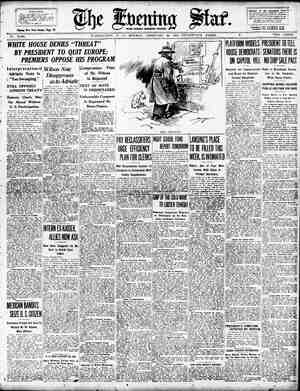The Nonpartisan Leader Newspaper, February 16, 1920, Page 3
You have reached the hourly page view limit. Unlock higher limit to our entire archive!
Subscribers enjoy higher page view limit, downloads, and exclusive features.
In the interest of a square deal . for the farmers VOL. 10, NO. 7 Tonpartisén Teader Official Magazine of the National Nonpartisan League MINNEAPOLIS, MINNESOTA, FEBRUARY 16, 1920 A magazine that dares to prmt the truth WHOLE NUMBEE-230 Insurance For the’ People’s Benefit Working Out of North Dakota Laws Reveals Enormous Profits of Insurance Companies, Now Saved by the State - Bismarck Bureau, Nonpartisan Leader. Z]JEARLY a year ago (in the issue of March 10, 1919) the Nonpartisan Leader told of the insurance laws that had just been enacted by the Neorth Dakota legislature—hail in- - ¢ " surance for the benefit of the farmers; state fire and tornado insurance, covering all pub- lic buildings in the state; bonding insurance. to cover the bonds of all public officials in the state. It was predicted then that the hail insurance - assessment necessary, in addition to the flat tax of 3 cents an acre, would be 25 cents,-making the state hail insurance rate 28 cents an acre, compared with the minimum rate of 70 cents an acre charged by private companies for the same amount of in- surance. The Leader article also indicated that profits on- the fire and tornado business probably would run to 40 per cent of the premlums collected and that a large part of the bonding insurance premiums also would be clear profit. In respect to state hail insurance the Leader pre- diction came to pass exactly. In the year just past a 25-cent assessment covered all losses and expenses, making the cost of insurance, with the 3-cent tax added, precisely 28 cents an acre, as compared with private rates of 70 cents an acre and upwards. But the Leader, it appears, was too conservative in its predictions as to the savings possible under the fire and tornado and bonding insurance laws. The report of S. A. Olsness, North Dakota insur- ance commissioner, for state fire and tornado in- surance for the last five months of 1919 (the first five months during which the fire and tornado in- surance law was effective) shows expenditures in payment of both fire and tornado losses, salaries and expenses, of $4,764.98, as against income of $41,562.55. Approximately five-twelfths of .this was “earned premiums’—that is, the insurance has been covered during five of the 12 months for which it has been paid. On the five-twelfths basis the earned premiums figure at $17,318, as against total losses and expenses of $4,764. In other words, in- stead of saving only 40 per cent, state fire and tor- nado insurance has thus far saved better than 70 per cent! The total fire insurance written and in force to August 1, 1920, is $4,005,975.94. The total tornado insurance written for the same ‘period is $7,599,- 677.94. In the cases of both fire and tornado in- surance the rates charged are the same as those charged by the private insurance companies. The state of North Dakota, of course, does not intend to go into the insurance business as a mon- ey-making enterprise. The aim is to furnish the same protection as that given by the private in- surance companies at cost. Therefore.the North Dakota law provides that whenever a surplus of $200,000 is created rates can be reduced to a cost basis. The fund now has a cash b#lance of $22,621, and accounts and bills: receivable amounting to some $14,200 additional. .anything like “full force. The state law has not yet begun to function at The law prov1ded that contracts for insurance with private companies in existence before August 1, 1919 (when the law went into effect) should not be disturbed. Now it has happened in North Dakota, as elsewhere, that a good many insurance men, bankers having. in- surance agencies, and politicians having close friends in the insurance business, have been elect- ed from time to timé to county offices, school offices and the like. The new North Dakota law threaten- ed to take away some of the petty graft that such men had earned by pocketing commissions on pub- lic insurance premiums. So they got together and discussed ways of getting around the new law. The plan fin‘filly decided upon was to cancel, at some date prior.to August 1, 1919, existing con- tracts which were due to expire in the near future, and to make out'new three-year con”.acts with the private insurance companies, thus continuing the private graft a little longer. Not a'* the local of- ficials did this, but it was done to a considerable ex- tent in various sections all over the' state, estab- lishing beyond a reasonable doubt a well-understood conspiracy against the law. As the contracts with private companies expire even these districts will come under the state law. The incident has not seriously hampered the working out of the 'state ,law, but it has given the North Dakota farmers an insight into the petty graft prevailing in local politics and has determined the Leaguers tc clean (Continued on page 14) NAILING UP A FEW RAT HOLES T Vevik PAGE THREE . —Drawn expressly for the Leader by W. C. Morris, ~oyhA wnin v S5 iand otk








